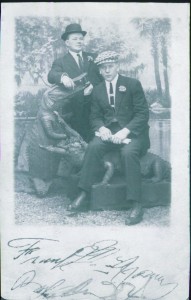While peeling potatoes, in preparation for yesterday’s St. Patrick’s Day dinner, I contemplated how these Andean tubers had affected the course of several generations in my family, and the irony of moving to the land of their origin. My thoughts drifted to my great-great-grandparents, Dennis and Bridget, who had immigrated to the United States during the potato famines. More than 1 million of their compatriots had died of starvation or related illnesses during the nearly full century of blight. One million more had emigrated to other countries in hopes of a full belly and even land to call their own.
It was to be our first St. Pat’s party, and I was feeling nostalgic for my heritage, as well as missing my family back home. I wondered if John and Bridget had shared similar feelings and expat experiences as my own. I also wondered how they would feel about a great-great-granddaughter who had chosen to move away from the country they had struggled to call home.
When feeling especially misty, I indulge in a little genealogical research. The research helps me to feel connected to my family. Although it sometimes feels more like an unrequited quest, I was blessed last year with the discovery of a family branch that no one among my surviving siblings even knew existed. With my newfound cousins, and the internet, we have been slowly piecing together the steps that our family has taken. As an added blessing, one cousin shared photos of a grandfather that I never had the opportunity to know (photo, sitting on alligator statue). All these discoveries all came about because I had made the decision to press forward for a new life, as had my great-great-grandparents, and was feeling a little expat blue from time to time.
Although our St. Pat’s party was far more reserved than those of years past (reserved is not a word used to describe a room full of American Irish!), it was wonderful to sit at the table with Chilean friends to partake in a little Irish comfort food. Although many familiar items were unattainable, such as ham, corned beef, Guinness, Bushmill, caraway, buttermilk, etc., we dined on roasted lamb, beef stew, mashed potatoes and salads. For dessert, I had made a plateful of oatmeal cookies, having just discovered fine brown sugar in the grocery that morning. Home baked cookies were a virtually unknown experience for my Chilean friends, prior to our moving here, so it’s always a joy for me to share a freshly baked batch.
As we sat around the table, talking, laughing, joking, I was struck by the convergence of cultures and languages. Gaelic, English and Spanish floated and intertwined in the air. Irish music would periodically be interrupted with Latin, and then ultimately finish with the wale of Miles Davis’ trumpet.
Instead of Guinness or Harp, Coronas and Escudo beer bottles littered the counters, and beautiful Chilean red and white wines graced the table, without a drop of pure Irish whiskey in sight. It was only in the appearance of Molly Irish Cream that the amber Irish drink could be found. In spite of the absence of familiar favorites, the essence of the day was felt. Indeed, it was even a novel experience to celebrate the holiday on its actual day, and not the Saturday before or after.
Although I am not sure that my friends here understand the heartfelt connection Irish Americans feel about St. Pat, our first celebration upon my immigrant soil will be one that I will remember for quite some time to come. Eirinn Go Brach!
